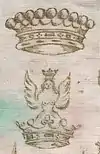Count de Salis-Soglio
Count de Salis-Soglio is a continental title of nobility that was recognized in the United Kingdom for a Swiss family which became British Subjects when Jerome, 2nd Count de Salis, was naturalized by private Act of Parliament (4 Geo. 2. c. 5) in 1741.
Emperor Francis I by a patent dated Vienna, 12 March 1748, had created his father, colonel and ambassador Peter de Salis, together with his descendants, Counts of the Holy Roman Empire.[1][2][3][4]: 331–356 [5][6][7][8][9]


On 4 April 1809 George III,[10] by royal licence,[11] granted and gave Jerome, 4th Count de Salis's descendants, of both sexes, those who were Subjects of Our Realm, the right to fully avail themselves of the title of Count of the Holy Roman Empire. The right to use the name of Fane before that of de Salis was granted, by Royal Licence and Authority as published in the London Gazette, on 11 December 1835.[12] In the same April 1809 licence the same Jerome de Salis-Soglio was granted assumption and use of the arms of Count, with the arms, crest and supporters of de Salis, with the quarterings of Fane, Neville, Beauchamp, and Le Despenser.[13] The de Salis are thus the oldest royal licence holders granted the Authority or Warrant to use their foreign titles in the United Kingdom; by 1930/1932 only 13 families of British Subjects were still using such hereditary authority.
Family history
The de Salis family[14] belongs to the old nobility of the Three Leagues (nowadays the Canton of the Grisons, Switzerland). They were one of its leading families between the 16th and 18th centuries and provided numerous presidents of the League of God's House. A notable member was the poet Johann Gaudenz von Salis-Seewis of the branch of the Counts de Salis-Seewis.
They probably descend from the patrician family Salici of Como, Italy, traceable since 1202. The name Salice means Salix caprea (the family coat of arms contains a salix – or goat willow – tree, along with the crest of the Bellona). At first the family appears in Soglio, Switzerland with ser Rodolfus de Salice de Solio between 1285 and 1293. In the 12th and 13th centuries, wealthy citizens of Como had settled in the area north of Lake Como due to the conflicts between the expanding Milan and the municipality of Como. Soglio is located at the beginning of the Val Bregaglia (Bergell valley) which at the time belonged to the Prince-Bishopric of Chur, and is presently situated on the border between Switzerland an Italy. The family became vassals of the bishop and built several tower houses in Soglio and the neighbouring Chiavenna. When the latter was sold by Chur to the Visconti of Milan in 1335, the Salis became their vassals as well. The Visconti dukes granted them trading privileges from 1391, which they kept until 1544. The tower houses in both communities were later converted into baroque palaces (there are 5 in Soglio alone, of which the Casa Battista, also known as Hotel Palazzo Salis, built in 1630 on an older structure, is still today owned by the Swiss Salis-Soglio line). So is the Palazzo Salis in Bondo, Switzerland, just across from Soglio on the other side of the valley, which was built by Jerome, 2nd Count de Salis, and which to this day is owned by the British Salis-Soglio branch.
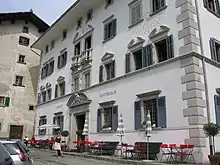 Soglio: Cas' Alta (left) and Casa Battista (Hotel Palazzo Salis, built in 1630, right), still owned by the Swiss family branch
Soglio: Cas' Alta (left) and Casa Battista (Hotel Palazzo Salis, built in 1630, right), still owned by the Swiss family branch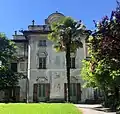 Palazzo Salis, Chiavenna
Palazzo Salis, Chiavenna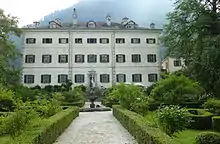 Palazzo Salis in Bondo, 1766–1776 built by Jerome, 2nd Count de Salis, and still today owned by the British family branch
Palazzo Salis in Bondo, 1766–1776 built by Jerome, 2nd Count de Salis, and still today owned by the British family branch The manor house at Grüsch, built by Hercules von Salis-Soglio in 1590
The manor house at Grüsch, built by Hercules von Salis-Soglio in 1590
The family gradually expanded their property northwards beyond the Val Bregaglia into the Upper Engadin (Celerina, Samedan, Zernez) and Prättigau valleys, and later also into Domleschg valley. The heyday of the family began in the 16th century, after the establishment of the Free State of the Three Leagues which ended the Prince-bishop's power in 1524.

During the Bündner Wirren (Revolt of the Leagues between 1618 and 1639), several members of the Salis family, such as Hercules von Salis-Soglio-Grüsch (1566–1620), a propagator of reformed Protestantism, and his son Ulysses von Salis (1594–1674), stepped on the French-Venetian side, being mercenary leaders who guarded the Alpine passes, and thus gained considerable influence on the country's fortunes, whereas their main rivals, the mostly Roman Catholic von Planta family, led the Austrian-Spanish side. The rivalry culminated with the assassination of Pompeius Planta in 1621 in a castle that he shared with the Salis-Grüsch. During the 17th and 18th centuries, the family became the predominant noble house of the Three Leagues, after ousting the Plantas. Ulysses acquired Marschlins Castle and restored it to its still preserved glory. Among many other estates and manor houses, Haldenstein Castle (1703 until 1922), and the Upper and Lower manors at Zizers were built or owned by the family. Bothmar Castle at Malans, Switzerland, is the current seat of the Counts de Salis-Seewis. A German branch, the Barons von Salis-Soglio, inherited Gemünden Castle in 1822, and still own it.
The family's political power was not broken until the Helvetic Republic put an end to the Three League's sovereignty in 1798. Franz Simon von Salis-Zizers, commander of the 7th French Guards Regiment of the Bourbons and in 1809 President of the League of God's House carried out a coup in 1814. In 1832 he led Pope Gregory XVI two Swiss regiments to assert the Papal State. General Johann Ulrich von Salis-Soglio was commander-in-chief of the conservative Sonderbund alliance in the Sonderbund War in 1847, while Johann Gaudenz Dietegen Count von Salis-Seewis took part in the Revolutions of 1848 as the radical democratic commander of a militia; in 1850 he was governor in Chur.
Jerome, 2nd Count de Salis (1709–1794), whose father had been ambassador in London, married Lady Mary Fane, a daughter of Charles Fane, 1st Viscount Fane, of the Earls of Westmorland, only to be sent back by King George II as British envoy to the Three Leagues. Ever since, the family has continued to commute between England and Switzerland, being citizens of both countries. A present-day seat is Yarlington House, Somerset, besides Palazzo Salis in Bondo.
Lineage
.pdf.jpg.webp)
.jpg.webp)
- Peter (Pierre, L'envoyé, or Pietro l'Inviato), 1st Count de Salis, 'Envoy Extraordinary of the Grisons to Her Majesty', arrived Court of St. James's, 12 July 1709;[7][15]
- Jerome/Hieronimus, 2nd Count de Salis, Naturalized British Subject by private Act of Parliament, the Naturalization of Hieronimus de Salis Act 1730 (4 Geo. 2. c. 5), 24 March 1730/1731,[16]: 231, 146–147 and married, by the Archbishop of York, Hon. Mary Fane, 7 January 1734/35, eldest daughter of Charles, (1st), Viscount Fane;[15][17]
- Peter, 3rd Count de Salis, DL, JP, inherited his mother's share of the Bourchier/Fane estates in County Limerick and County Armagh;[15]
- Jerome, 4th Count de Salis-Soglio, DL, JP;[15][16]: 146–147 [18]
- Peter, 5th Count de Salis-Soglio, DL, JP;[3][15][19][20][21]
- John Francis William de Salis, 6th Count de Salis-Soglio, diplomat and numismatist;[15]
- Sir John Francis Charles de Salis, 7th Count de Salis-Soglio, KCMG, CVO.[4]: 331–356 [15][16]: 13
- John Eugène de Salis, 8th Count de Salis-Soglio.[4]: 331–356 [16]: 13
- John Bernard Philip Humbert de Salis, 9th Count de Salis-Soglio, TD.[22][23]
- John-Maximilian Henry de Salis, 10th Count de Salis-Soglio.[24]
- John Arthur Francis Maria de Salis, 11th Count de Salis-Soglio.
_by_Kneller%252C_circa_1710.jpg.webp) 1st Count.[25]
1st Count.[25]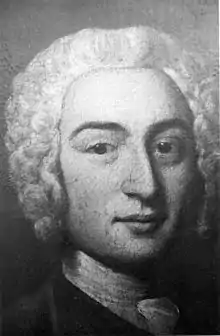 2nd Count.
2nd Count. 3rd Count.
3rd Count..jpg.webp) 4th Count.
4th Count..jpg.webp) 5th Count.
5th Count.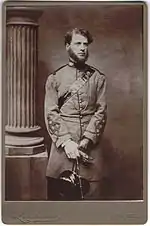 6th Count.
6th Count. Sir John Francis Charles de Salis, 7th Count de Salis-Soglio, KCMG, CVO
Sir John Francis Charles de Salis, 7th Count de Salis-Soglio, KCMG, CVO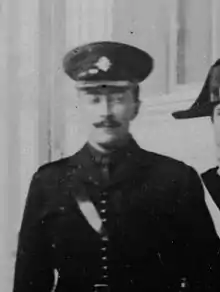 8th Count.
8th Count. 9th Count.
9th Count.
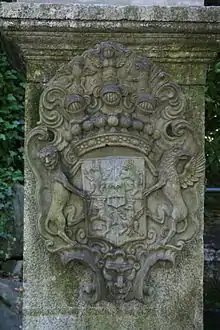

UK royal licence granted to the 4th Count on 4 April 1809, reiterating in English the 1748 Imperial patent
 Cover of Licence
Cover of Licence Page one of Licence
Page one of Licence Page two of Licence
Page two of Licence Page three of Licence
Page three of Licence Page four of Licence
Page four of Licence
Source: [26]
Some notable houses or land, owned or built by Counts de Salis-Soglio
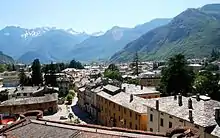 Chiavenna. 1st Count built orange coloured house to the right.
Chiavenna. 1st Count built orange coloured house to the right. Altes Gebäu, Chur/Coire. 1st Count built this.[27]
Altes Gebäu, Chur/Coire. 1st Count built this.[27] Altes Gebäu, interior
Altes Gebäu, interior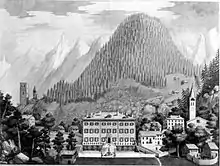 Palazzo Salis in Bondo in Bregaglia. 2nd & 3rd Counts built this.
Palazzo Salis in Bondo in Bregaglia. 2nd & 3rd Counts built this.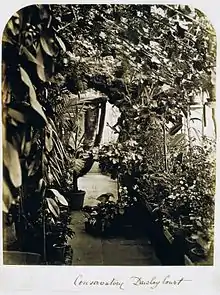 Dawley, south of Hillingdon. 4th Count lived here.
Dawley, south of Hillingdon. 4th Count lived here.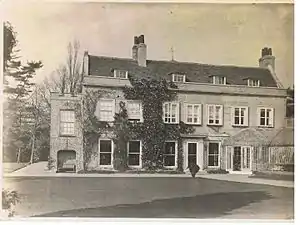 Dawley Court, Goulds Green, Hillingdon, Middlesex, c1890.
Dawley Court, Goulds Green, Hillingdon, Middlesex, c1890.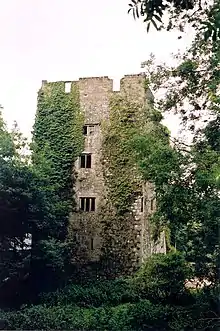 Bourchier Tower, at the heart of Bourchier & Fane derived Irish estate in county Limerick.
Bourchier Tower, at the heart of Bourchier & Fane derived Irish estate in county Limerick.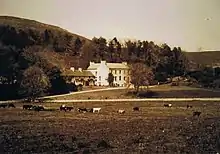 Lough Gur House (Grange Hill), county Limerick. 7th Count lived here.
Lough Gur House (Grange Hill), county Limerick. 7th Count lived here..jpg.webp) Portnall Park, Virginia Water, Surrey, UK, owned by the de Salis family between 1872 and 1923
Portnall Park, Virginia Water, Surrey, UK, owned by the de Salis family between 1872 and 1923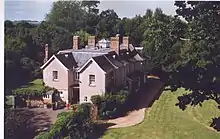 Bourne House, East Woodhay, Hampshire, UK, owned between 1946 and 2006
Bourne House, East Woodhay, Hampshire, UK, owned between 1946 and 2006 Lough Gur, 2005. The lake was sold to Limerick County Council by the 9th Count in 1979.
Lough Gur, 2005. The lake was sold to Limerick County Council by the 9th Count in 1979.
Countesses de Salis-Soglio
 Hon. Mary Fane, wife to 2nd Count.[25]
Hon. Mary Fane, wife to 2nd Count.[25] Anna v. Salis-Sogio, third wife to 3rd Count.[25]
Anna v. Salis-Sogio, third wife to 3rd Count.[25] Sophia Drake, first wife to 4th Count.[25]
Sophia Drake, first wife to 4th Count.[25] Penelope Freeman, second wife to 4th Count.[25]
Penelope Freeman, second wife to 4th Count.[25]_3rd_wife_to_Jerome%252C_4th_Count_de_Salis-Soglio.jpg.webp) Henrietta Foster, third wife to 4th Count.[25]
Henrietta Foster, third wife to 4th Count.[25].jpg.webp) Cecile Henrietta Marguerite Bourgeoise, second wife to 5th Count.[25]
Cecile Henrietta Marguerite Bourgeoise, second wife to 5th Count.[25]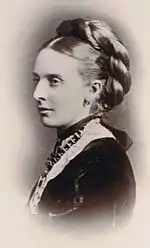 Amelia Frances Harriet Tower, wife to 6th Count.[25]
Amelia Frances Harriet Tower, wife to 6th Count.[25]
Some countly arms
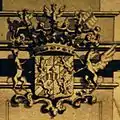 Chiavenna
Chiavenna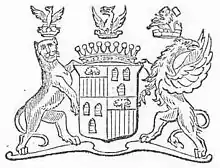 From 1851 edition of Burke's Peerage (Foreign Titles section)
From 1851 edition of Burke's Peerage (Foreign Titles section) Debrett's Peerage, London, 1888.
Debrett's Peerage, London, 1888.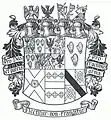 Armorial Achievement from Fox-Davies, 1929
Armorial Achievement from Fox-Davies, 1929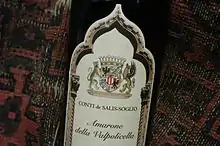
_of_the_Counts_de_Salis-Soglio%252C_made_in_England%252C_in_watercolour.jpg.webp)
 Debrett's Peerage 1888, Foreign Titles of Nobility section, page 822.
Debrett's Peerage 1888, Foreign Titles of Nobility section, page 822.
Some crests and coronets
(This page concentrates on the senior line, (the anglicised primogenitive interpretation of the patent). Elsewhere, the 'category' below and disambiguation page De Salis, there are others within the purlieu of the 1748 creation).[7]
References
- Genealogisches Handbuch des Adels, Band 146, Gräfliche Häuser XIX, 2009, XXVIII + 619 Seiten, 50 Bilder davon 11 farbig, 37 Genealogien, ISBN 978-3-7980-0846-5, page 396-427.
- In recognition of (translated): '...his famous integrity & prudence whilst in the beginning of this century he gave repeated specimens of his diplomatic skill in his embassies to London and to the Hague, and afterwards being devoted to the most august House of Austria and the public welfare in the year 1741 he rendered vain and fruitless the pernicious project of the French to persuade the Grisons to take their part, & furthermore during this whole time with the most faithful attachment gave himself up to the good cause; & furthermore that his son Jerome for several years minister of England in the Grisons was always attentive to cement the bond, of friendship between the Holy Roman Empire the House of Austria, & the King in whose service he was...' '...Being then fully confident that as well he the said Peter de Salis as well as his son Jerome will not omit an opportunity of distinguishing themselves and of deserving well of us, the Holy Roman Empire, and the most Serene House of Austria; we consider him worthy of giving him some testimony of Our special seal and favour, and of transmitting it to the latest posterity...' '...and to his descendants as above this privilege that in future they may be perpetually named called and distinguished by us, and by our successors in the Holy Roman Empire, Emperors and Kings, with the title of Illustrious and Magnificent, High and Well born,...'
- John Burke (1852). A Genealogical and Heraldic Dictionary of the Peerage and Baronetage of the British Empire. Colburn & Company. p. 1096.
- Gräfliche Hauser, Band XI [volume 11], Genealogisches Handbuch Des Adels, C. A. Starke Verlag, Limburg an der Lahn, 1983
- Burke's Peerage, Foreign Noblemen / Foreign Titles sections: 1839, 1851, 1936, 1956, etc. and Debrett's Peerage, Foreign Titles of Nobility section, 1888, page 822; etc.
- Fane de Salis MSS
- De Salis Family : English Branch, by Rachel Fane De Salis, Henley-on-Thames, 1934.
- From Home Office notes made 21 May 1930 by A. J. Eagleston: 'Count de Salis, Count of the Holy Roman Empire, created 12th March, 1748. Date of Licence.—4th April, 1809. Grantee.—Jerome de Salis. Limitation of Licence.—Limited to the grantee and those of his family being subjects of the Realm. Remarks.—By origin the de Salis are a Swiss noble family from the Grisons. In the early 18th century, Peter de Salis was Imperial Ambassador in England, and was given the Countship, presumably for his diplomatic services. His son was naturalized in England.'
- Siegel und Wappen Der Familie Von Salis von Einem Mitglied Der Familie, (compiled by Nicolaus von Salis-Soglio), Basel : Birkhauser & Cie, 1928.
- Whitehall, April 4, 1809. The King has been graciously pleased to give and grant unto Jerome De Salis, of Hillingdon, in the County of Middlesex, Esq; Count of the Holy Roman Empire, eldest Son and Heir of Peter De Salis, late of the same Place, Esq; also Count of the Holy Roman Empire, deceased, His Royal Licence and Authority, that in consideration of the Duties and Services performed by different Members of the ancient and distinguished Family of De Salis, he the said Jerome De Salis, and those of his Family, being Subjects of His Majesty, and on whom the Dignity of Count of the Holy Roman Empire shall have devolved, or shall devolve, in virtue of the Limitations in the Imperial Letters Patent, or Diploma, granted by Francis the First, Emperor of Germany, unto Peter De Salis, Great Grandfather of the said Jerome De Salis, bearing Date at Vienna , the 12th day of March 1748, may fully avail himself and themselves of the said Honour, assume and use the Title thereof in this Country, and bear the Arms annexed thereto : And also to order, that this His Majesty's Concession and especial Mark of His Royal Favour, together with the said Imperial Letters Patent or Diploma, may be registered in His College of Arms.
- By 1930/1932 only 13 families of British Subjects were still using this hereditary authority (Royal Licences, Authority or Warrant to use their foreign titles); the De Salis having the oldest licence. (Listed in a Royal Warrant of April 27, 1932 on Foreign Titles), (see: 547,423/5, 21/7/30, HM The King (Private Secretary) gives HM's views on H.O. (Home Office) suggestions on Royal Licences for the use of Foreign Titles, to Sir Malcolm Delevingne).
- Whitehall, December 11, 1835. The King has been pleased to give and grant unto Jerome Count De Salis, His Majesty's royal licence and authority that, in order to commemorate his inheritance of considerable estates in Ireland from his great uncle Charles the last Lord Viscount Fane, of the kingdom of Ireland, as well as his descent from, and co-representation of, Charles the first Viscount Fane, he, the said Jerome Count De Salis, and his issue may take and use the surname of Fane, in addition to and before that of De Salis, and that he and they may bear the arms of Fane quarterly, in the second quarter, with his and their own family arms; such arms being first duly exemplified according to the laws of arms, and recorded in the Heralds' Office, otherwise the said licence and permission to be void and of none effect: And also to command, that the said royal concession and declaration be registered in His Majesty's College of Arms.
- London Gazette
- See German article Salis
- Stammbaumes der Familie von Salis von Anton von Sprecher, Chur, 1941
- The Nobilities of Europe, by the Marquis de Ruvigny, aka Melville Henry Massue, 1909
- Edward Wedlake Brayley; John Britton (1816). The Beauties of England and Wales, Or, Delineations, Topographical, Historical, and Descriptive, of Each County: Middlesex. T. Maiden. p. 621.
- The Gentleman's Magazine. Vol. 7. W. Pickering. 1837. p. 546.
- Memoir of the Illustrious and Sovereign Order of St. John of Jerusalem, from the capitulation of Malta in 1798 to the present period...and presenting a more detailed account of its sixth or British Branch as re-organised in 1831, by Robert Bigsby, Derby, 1869. (Pages 152–155)
- Whitehall, July 21, 1842. The Queen has been pleased to grant unto Peter-John Fane-de-Salis, Count de Salis, Her royal licence and permission, that he may accept and wear the insignia, of the third class, of the Royal Prussian Order of the Red Eagle, which His Majesty the King of Prussia hath been pleased to confer upon him, in testimony of His Majesty's approbation of his conduct while in the actual service of his Majesty during the insurrection at Neufchatel, in the year 1831; and that he may enjoy all the rights and privileges thereunto annexed; provided, nevertheless, that Her Majesty's said licence and permission doth not authorize the assumption of any style, appellation, rank, precedence, or privilege appertaining unto a Knight Bachelor of these realms : And also to command, that Her Majesty's said concession and especial mark of Her royal favour be registered, together with the relative documents, in Her Majesty's College of Arms.
- Commission signed by the Lord Lieutenant of the County of Middlesex. Loyal Uxbridge Volunteers. Count Peter Fane De Salis to be Captain Commandant, vice Riches, resigned. Dated 13th September 1837.
- Burke's Irish Family Records, ed. Hugh Montgomery-Massingberd, Burke's Peerage Ltd, London, 1976.
- Debrett's#Debrett's People of Today
- Genealogisches Handbuch des Adels, Band 146, Gräfliche Häuser XIX, 2009
- Photographien der Bilder von Vorfahren der Familie von Salis, Chur, 1884.
- Fane de Salis MSS/Sammlung Fane de Salis
- de:Altes Gebäu (Chur)

.jpg.webp)
